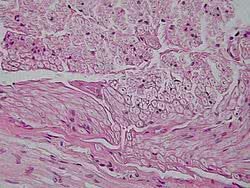Ecological pyramids are graphical representations of trophic interactions between species in a community.
They represent the flow of energy and matter between trophic levels along the food chain.
At the base of the pyramid are producers, followed by herbivores and carnivores. At the highest level of the pyramid are the beings at the top of the food chain.
Ecological pyramids can be of three types: number, biomass and energy.
number pyramid
The number pyramid represents the number of individuals in each trophic level.
Example: if in a community we have 500,000 herbs (producers), 50,000 herbivorous rodents (primary consumer), 10,000 snakes (secondary consumer) and 10 eagles (tertiary consumer), the number pyramid is the Following:
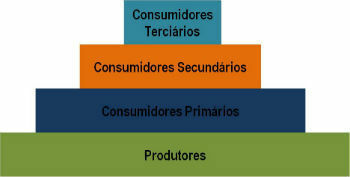
direct number pyramid
In some situations, the number pyramid can be inverted.
Example: Consider a community where the number of producers is low. In this case, a single large tree serves as food for a large number of herbivores. So we have the inverted number pyramid.
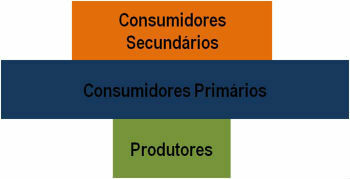
Inverted number pyramid
Biomass Pyramid
The biomass pyramid represents the amount of organic matter present in the body of organisms at each trophic level.
Example: if in a community we have the following amounts of biomass at each trophic level, the biomass pyramid will be represented as in the figure:
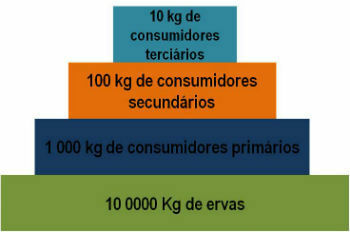
Biomass Pyramid
The biomass pyramid can also be inverted.
Example: In an aquatic ecosystem, the phytoplankton is the main producer, it reproduces quickly and has a short life cycle. At times, the biomass of phytoplankton may be smaller than the biomass of beings from other trophic levels, such as zooplankton and fish. This situation causes the biomass pyramid to be inverted.
know more about biomass.
energy pyramid
The energy pyramid indicates the energetic magnitude of trophic interactions in a community. It is the most complex of the three types of ecological pyramids and encompasses information on primary and secondary production.
The flow of energy through the food chain decreases towards higher trophic levels. Thus, energy decreases from the bottom to the top, because part of the energy is incorporated by each trophic level and another part is dissipated in the form of heat.
Therefore, the shorter the food chain, the more energy will be used.
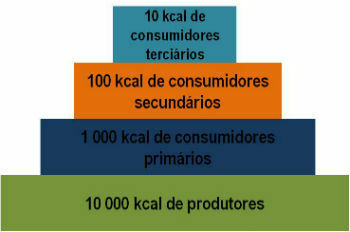
Energy Pyramid
The energy pyramid will never be inverted. Producers always store the greatest amount of energy.
know more about:
- food web
- Food chain
- Trophic Levels
- ecosystem
- Ecology Exercises
Exercises
1. (VUNESP) Consider the following three food chains.
I. vegetation → insects → amphibians v snakes → fungi.
II. vegetation → rabbit → hawk.
III. phytoplankton → zooplankton → fish → shark.
The greatest amount of energy available for the higher trophic levels will be:
a) only in chain I.
b) only in chains I and III.
c) only in chain II.
d) only in chains I and II
e) in chains I, II and III.
c) only in chain II.
2. (UERN) An inherent characteristic of food webs is:
a) the increase in energy when moving from one trophic level to another;
b) the cyclical transfer of energy along food chains;
c) the same organism can occupy more than one trophic level;
d) the higher the trophic level, the greater the number of organisms occupying them;
e) the cycle of matter is disconnected from the action of decomposers.
c) the same organism can occupy more than one trophic level;
3. (FEI-SP) In an ecosystem, a fungus, an owl and a rabbit can play the roles, respectively, of:
a) decomposer, 2nd order consumer and 1st order consumer.
b) producer, 1st order consumer and 2nd order consumer.
c) 1st order consumer, 2nd order consumer and 1st order consumer.
d) 2nd order consumer, 3rd order consumer and 1st order consumer.
e) decomposer, 1st order consumer and decomposer.
a) decomposer, 2nd order consumer and 1st order consumer.
See too: Food Chain Exercises



